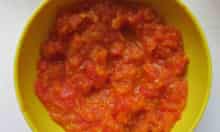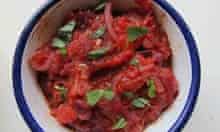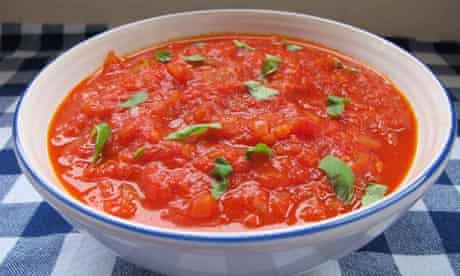Is Tomato Sauce Nice in Mindnced Beef
A good tomato sauce is one of the first things that any cook should learn to make – it is almost infinitely useful, keeps pretty well, and the ready-made version is outrageously overpriced. Indeed, Marcella Hazan writes in The Essentials of Classic Italian Cooking: "No other preparation is more successful in delivering the prodigious satisfactions of Italian cooking than a competently executed sauce with tomatoes."
I have made any number over the years to toss with meatballs and spaghetti, to coat cannelloni and to top pizzas, and they have rarely disappointed – but not one has knocked my socks off. You might fairly observe that knocking one's socks off isn't the point of a simple tomato sauce, but it ought to be good enough to need no further adornment. No parmesan, or minced beef, or spinach and ricotta – a simple pasta al pomodoro, well made, is a beautiful thing.
The tomatoes

In Italy, we are led to believe, decent tomatoes are a given in the summertime – sadly, that is still not the case in this country, although it is getting far easier to find really ripe, ruddy specimens at farmers' markets and better supermarkets. Hazan recommends using "fresh, naturally and fully ripened plum tomatoes" where available, saying that other varieties may be used "if they are equally ripe and truly fruity", but that, if no completely satisfactory examples are available, "it is better to use tinned imported Italian plum tomatoes".
Angela Hartnett, in her book Cucina, admits: "It's difficult to get really flavoursome tomatoes outside the Mediterranean, so don't be afraid to make sauces using canned plum tomatoes instead." As Anna del Conte advises when using fresh, but insipid fruit, Hartnett adds tomato puree and a pinch of sugar "to cut through the acidity of the tomatoes", promising "you'll be amazed at the difference it makes to the finished sauce". Hartnett's sauce lacks the fresh sharpness of some of the others, but it is still gorgeously fruity, though I think a little more reducing is necessary to really concentrate the flavour. In place of the puree, I am going to add a dash of vinegar to replicate that elusive sharpness.
Giorgio Locatelli, meanwhile, writes that "for a fresh salad or sauce", there is no doubt that "the round, ridged Cuore di Bue is the superior tomato". They are expensive, these fancy imported tomatoes, but we have to grudgingly concede that the flavour is excellent – "very fresh". If you can get them or, indeed, any really robustly flavoured tomatoes, clutch them to your bosom and don't let go, but if they are even bordering on the bland, then go for good, tinned fruit, every time. Even the best kind won't be as pricey as disappointing "heirloom" tomatoes.
Hazan advises blanching and skinning the tomatoes, or cooking and sieving them before use (the latter for a silkier sauce), while Del Conte sieves the sauce after cooking. Sieving gives a very smooth sauce, almost like soup, but with a lot of waste – all the other vegetables go in the bin. In any case, I prefer a chunkier texture, so blanching seems the way to go.
The onions

Rose Gray and Ruth Rogers in the River Cafe Classic Italian Cookbook reckon the onion is a cornerstone of the classic sugo di pomodoro, but while most recipes call for a standard yellow version, they go for red, thinly sliced and cooked to melting sweetness before a tomato has so much as hit the pan. Hartnett also softens her onions before adding the remaining ingredients, while Del Conte and Hazan simmer them all together. Locatelli doesn't use them at all.
The onion helps to balance the natural acidity of the tomatoes, but you certainly don't need as much of it as Gray and Rogers suggest. For a versatile sauce, I think yellow are preferable.
Hartnett, Gray and Rogers and Del Conte also use garlic in their sauces (thus putting to bed once and for all, I hope, the notion that Italian cooks never use them together) – and indeed, a little garlic is never a bad thing where a tomato is concerned.
Herbs and aromatics

A surprising array on offer here: Hartnett uses rosemary, Locatelli and Gray and Rogers basil, and Del Conte parsley, sage and thyme. The rosemary has its fans, although I find it too strong, but the basil seems like the best match with the other ingredients, and, when added to the sauce as it cooks, as in Locatelli's recipe, it does an excellent job at infusing flavour.
Del Conte also simmers celery and carrot in the sauce, as if making a savoury, meaty ragu – apparently it's northern Italian in style, but I want my simple tomato sauce to taste predominantly of just that, so I'm going to leave them out.
Fat
Hazan adds a large knob of butter to her sauce, while Hartnett, Locatelli, Rogers and Gray stick with the more obvious olive oil, and Del Conte only allows a little butter or oil when reheating it for use with pasta. Hazan's sauce is overwhelmingly rich – perfect for serving over a couple of ravioli perhaps, but a bit much for a whole plate of spaghetti. The oil is much nicer – I find Del Conte's sauce a little bit spartan without it.
Hartnett also finishes the sauce with a drizzle of oil, which is rarely a bad thing.
Cooking time
Del Conte explains that "to make a good tomato sauce, you can either cook the tomatoes for a very short time or let them bubble for at least 40 minutes", because they only begin to release their acid juices after about 10 minutes, and these take at least half an hour's simmering to evaporate. Thus, if one has really, really good tomatoes, they only need to see the briefest of heat but, frankly, if you can find fruit that good in this country, you should probably enjoy it au naturel.
In any case, this explains why all the recipes, except Hartnett's with its tinned tomatoes (though including Gray and Rogers' offering, though they also use tinned fruit), demand a long, slow simmer of between 45-50 minutes: and indeed, Hartnett's could do with a little more reducing for my taste. Del Conte allows for adding a little vegetable stock or hot water if it looks as if it is boiling dry, but it seems fine to me.
Interestingly, Locatelli calls for you to simmer the tomatoes in a covered pot, while Hazan expressly cautions against such a move, writing: "Never cook a sauce in a covered pan: it will emerge with a bland, steamed, weakly formulated taste." I'm inclined to agree: though Locatelli's sauce is delicious, it lacks the body and richness of some of the others.
If you are going to eat the sauce straight away, then go right ahead and generously anoint your pasta – otherwise, pour into sterilised containers and refrigerate or freeze until ready to use. And with tomato sauce, that is unlikely to be very long.

The perfect tomato sauce
800g good, tinned plum tomatoes or ripe fresh fruit
2 tbsp olive oil
1 small onion, finely chopped
2 garlic cloves, crushed
1 tsp sugar
Dash of red-wine vinegar
3 stems of fresh basil
Extra-virgin oil, to serve (optional)
If using fresh tomatoes, drop them into a pan of boiling water and leave for about a minute, until the skins split. Lift out and peel, then roughly chop.
Heat the oil in a medium saucepan on a medium-low heat and add the chopped onion. Soften for about five to seven minutes, until translucent but not coloured. Stir in the garlic and cook for another two minutes.
Tip in the tomatoes, and break up with a wooden spoon if necessary, then add the sugar, vinegar and the stems of the basil, reserving the leaves. Season lightly.
Bring to a simmer, then turn down the heat and simmer for 45 minutes, stirring occasionally, until thick.
Test the seasoning, add the basil leaves, roughly torn, and drizzle in a little extra-virgin olive oil if you like before serving.
Tomato sauce: laughably basic cookery, or harder than it looks, especially in the UK? And what special twist do you give yours? Non-Italian variations particularly welcome.
coopersciusurturs.blogspot.com
Source: https://www.theguardian.com/lifeandstyle/wordofmouth/2013/aug/01/how-to-make-perfect-tomato-sauce
0 Response to "Is Tomato Sauce Nice in Mindnced Beef"
Post a Comment